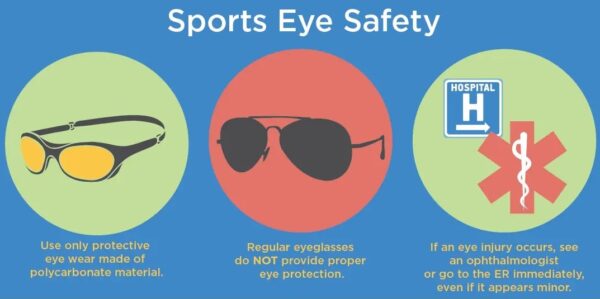
Every sport involves a degree of rigor and ability, and every sport carries a degree of injury risk. Of the nearly 30,000 ER visits for sports-related eye injuries each year, an astounding 90 percent could be avoided if protective eyewear were worn. Youth and adults alike state a range of reasons for not wearing sports eye protection: “They’re cumbersome … It compromises my peripheral vision … Sports goggles fog up and I can’t see.” From low- to high-intensity recreation, from youth recreation to pro leagues, protecting one’s eyes against potentially blinding sports-related injuries as an active person is requisite.
Between April and August, outdoors recreation peaks to highest levels. Accordingly, the American Association of Ophthalmology (AAO) recognizes April as Sports Eye Safety Month. This month, the AAO emphasizes several preventive actions that active Americans can employ to greatly reduce their risk for eye injury while engaged in sports play.
- START EARLY: Parents, coaches and others involved in organized youth sports can set a standard through requiring protective eyewear for youth playing sports that carry a higher risk of eye injury. Those who use protective eyewear consistently (every time) from an early age are far more likely to maintain such practice over the life course of engagement in a higher-risk sport.
- OPTICIANS ARE HIGHLY TRAINED TO ASSIST CHOICE OF PROTECTIVE EYEWEAR
- The AAO recommends shatterproof plastic protective glasses (polycarbonate lenses) for mainstream sports such as basketball, tennis, racquet ball, soccer and field hockey. Opticians can review options with active individuals who want to make protective eyewear a consistent part of their injury-preventing sports gear.
- Eyeglasses are no substitute for protective eyewear: Opticians are trained to assist eyeglasses and contact lens wearers choose the right pair of prescription protective goggles to participate in their sport. Visit the UNC Optical Shop at UNC Kittner Eye Center (2nd floor) or call their team (984-974-2039) with questions on recommended protective eyewear for your sport.
- KNOW THE RISK OF OCULAR INJURY IN YOUR CHOSEN SPORT: Injury is inherent to ALL sports. The sports that carry the greatest risk of head and musculoskeletal trauma go hand in hand with highest risk of ocular trauma. Athletes involved in close contact sports or others with higher rates of blunt force trauma stand the greatest risk of ocular injury in such sports.
- Basketball is the leading cause of sports-related eye injuries in the U.S. Boxing and full-contact martial arts also pose an extremely high risk of serious, even eye-blinding injuries. Activities involving projectiles that can veer directly into the eye’s orbit pose the greatest risk for temporary or permanent loss of eyesight.
- SPORTS-RELATED CONCUSSIONS CAN IMPACT VISION: Concussions in contact sports can cause temporary or long-lasting damage to eyesight. Results from on-the-field visual tests post-incident greatly aid eye specialists in assessing any concussion-related damage to a patient’s vision. If you have suffered a recent concussion, check with your diagnosing physician to ensure you have a timely referral to an ophthalmologist if any negative effects on vision are suspected.
- SPECTATORS CAN ALSO BE AT RISK. The odds of eye injury at sporting events with flying balls and other projectiles are far lower for spectators; nonetheless, misdirected kicks, pop-fly balls, and projectiles can end up in spectator stands at any time. Keep your eyes on the game and watch the fast-flying action involved in ice hockey, baseball, tennis and soccer and other sports where spectator eye injuries have occurred.
UNC Ophthalmology is among several UNC School of Medicine departments and divisions that lend disciplinary expertise to the University’s designated physician group for treating, rehabilitating and preventing injury in UNC athletes — UNC Division of Sport Medicine. UNC Assistant Professor of Ophthalmology Michael Mendsen, OD, serves in a mostly prevention-focused consultation role in working with UNC Sports Medicine’s athletic training program. Dr. Mendsen works routinely with UNC men’s basketball team trainers and presents an annual lecture to this group entitled, “Ophthalmologic Considerations for Athletic Trainers.”
Dr. Mendsen noted: “The athletic trainers for every [University of North Carolina] team do an excellent job of ensuring that the players have the necessary eye protection. When serious ocular trauma occurs, our UNC Oculofacial Plastic and Reconstructive Surgery group provides swift and comprehensive treatment and follow-up, working closely with both athletic trainers and the injured athlete [him/herself].”
UNC Assistant Professor of Ophthalmology Chris Hwang, MD, specializes in Oculofacial Plastic & Reconstructive Surgery. Dr. Hwang noted: “The orbital bones that surround and protect the eye within the brow, nasal, and cheek often absorb most of the damage from a forceful impact, sparing the eye of serious injury. If forceful enough, however, impact to the eye and/or surrounding areas can result in fractures of the orbital and facial bones, as well as damage to the eye that may result in vision loss, and, in the worst cases, rupture and loss of the eye itself. The eye is particularly susceptible to injury from high velocity objects small enough to fit into the orbit and deliver a direct impact to the eye. Wearing the proper eye protection while playing sports can help prevent serious eye injuries.”
If you have experienced an eye injury that necessitates follow-up treatment post emergency care, call 984-974-2020 to schedule an appointment with one of UNC Ophthalmology’s Periocular and Facial Trauma specialists. Our UNC Ophthalmology subspecialists who treat ocular injuries emphasize a proper recovery timeline for safe return to activity as equally important to treating the injury itself.
